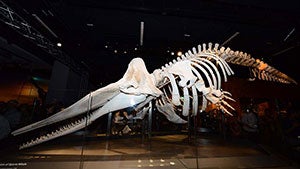 The Jubilee Whale exhibit is now open to the public
The Jubilee Whale exhibit is now open to the public
Applause and cheers broke out as the curtains dropped to reveal the long-awaited Jubilee Whale exhibit on 14 March. Fondly nicknamed “Jubi Lee”, the animal was recovered off the coast of Singapore in July last year by the Lee Kong Chian Natural History Museum (LKCNHM) at NUS.
The nearly complete skeleton of the 10.6-metre sperm whale, mounted at the Museum Gallery in the mammal section, was unveiled by Ms HO Ching, Chief Executive Officer of Temasek Holdings. Other distinguished guests included Dr Vivian BALAKRISHNAN, Minister for Foreign Affairs; Mr S DHANABALAN, Chairman of Temasek Trust and Mandai Safari Park Holdings; Prof Tommy KOH, Ambassador-at-Large and Chairman of the Museum’s Advisory Board; NUS Trustees Madam Kay KUOK and Mr NG Wai King; NUS President Prof TAN Chorh Chuan; Prof SHEN Zuowei, NUS Science Dean; and Prof Leo TAN, Director (Special Projects), NUS Science.
More than 250 donors and supporters of the whale also attended the event. With the help of the Museum’s many individual and corporate supporters such as Temasek Holdings, Wildlife Reserves Singapore and Mandai Safari Park Holdings, NUS has raised over $1.3 million for the Jubilee Whale Fund. This fund goes towards the restoration and maintenance of the whale, as well as marine biodiversity education, research and conservation.
Singapore’s first complete whale skeleton was obtained in 1892 from Malacca and had long been the centrepiece at the old Raffles Museum. However, it was gifted to Malaysia in 1974. With the opening of the new LKCNHM last April, there has been substantial interest in bringing this whale back to Singapore.
Prof Peter NG, Head of LKCNHM noted, “As fate would have it, last year after we opened the Museum, right in the middle of our Jubilee Year celebrations, a large whale washed up off Jurong. Over the period of eight-plus months, we’ve taken the carcass of the floating sperm whale, processed it, cleaned it, enough for a wonderful exhibit, and still make the Jubilee Year.”
He added, “Some nine months to deliver a whale from a carcass to an exhibit is a record time.”
Prof Ng lauded the tireless efforts of staff, volunteers and various government agencies in enabling the Museum to secure the whale and make the impressive exhibit possible.
The whale is now on public display. Those interested in contributing to the Jubilee Whale Fund can do so online.
See Channel NewsAsia coverage and The Straits Times online article.
Article and photos courtesy: NUS News


